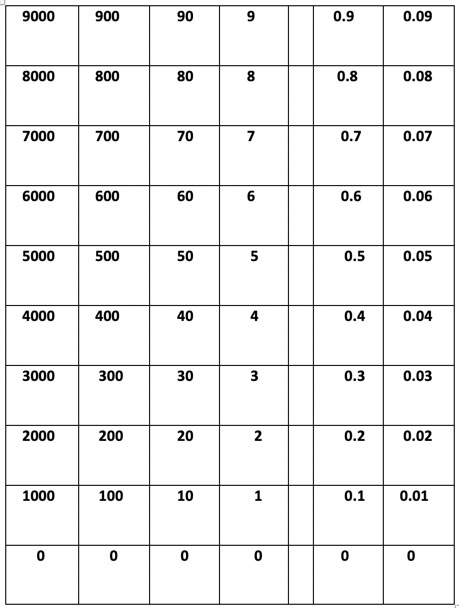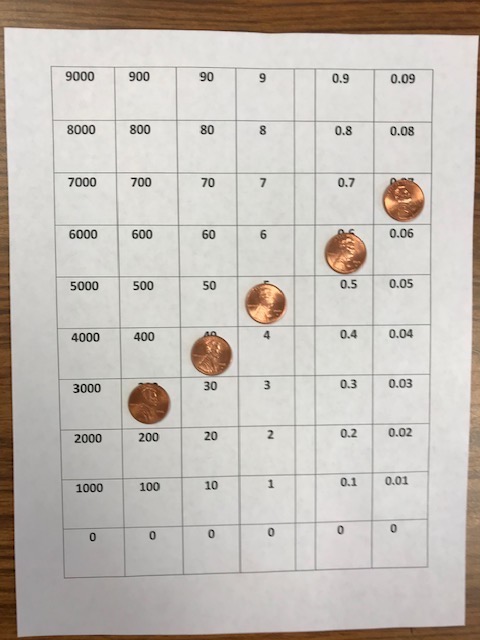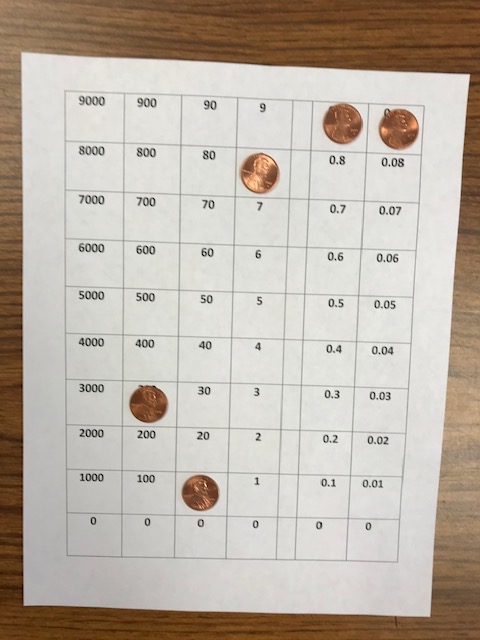The addition board is a device that can be used for addition and subtraction of positive decimals in the range 0 to 9999.99 with an accuracy of .01. Its use requires only the ability to count, and not addition facts; therefore it may be used by very young students as a problem solving tool. It may also be used as an educational aid in teaching decimal notation, including decimal fractions, and teaching written algorithms for addition and subtraction. Even if the board is used only for whole numbers with less than 4 digits, using the full size board is recommended.
Warning: Because the addition board allows children to perform addition and subtraction for a large range of numbers without knowing their addition facts, special care should be taken that they get enough practice with purely mental addition (without even counting on their fingers). We want to stress this because fast and perfect recall of addition facts is needed in so many situations that any deficiency can seriously impair a child's future learning of mathematics.
Activity
1. Description of the board and of the tokens: Draw 60 2 cm by 2 cm, squares on an 8 inch by 5 inch index card and label them as is shown on the diagram.

Most of the time you need no more than 6 tokens (one per column). But for some activities you may need up to 12 tokens (two per column). Pennies are good tokens, but you may also use metal nuts, wooden pegs, or even Unifix cubes. Heavier objects are better, and they should not roll.
2. Representation of numbers: Numbers written in decimal notation should be viewed in simplified expanded notation. So, for example,
Tokens are put in squares labeled by these numbers. So in this case, we have tokens on the squares [3000], [400], [50], [0.5], and [0.07].
Tokens put on squares labeled by 0, may often be omitted if you follow the normal rules for writing decimals:
12.30 = 12.3
But in the case of counting money, the normal conventions should be used. If you represent $5.40 on the board, you should put a token on [0] in the last column.
One step adding one non-zero-digit-number is done as follows:
Example 1: The number 345.67 is represented on the addition board
as shown here.  . . Example 2: If you add 1.33 to 345.67, you get 347.0, as shown here.  . . |
5. Subtraction: [top] You always subtract a new number from a number already on the board. The basic step is subtracting a number that has just one non-zero digit. Thus subtracting 503.02 consists of three steps, subtracting 500, subtracting 3, and subtracting 0.02. They may be subtracted in any order.
One step subtracting one non-zero-digit-number is done as follows:
Example 3: The number 321.05 is represented on the addition board,  . . Example 4: If you subtract 2.06 from 321.05, you get 318.99,  . . |
Other Activities
[top]
1. Making a board: Making a board is an activity in itself. And even if the physical layout is already made, writing in the numbers is a part of learning decimal notation. Students should learn to read all the numbers written on the board, because they are used in communication. For example, "Put a penny on one tenth and on five hundred and zeros in between."
2. Number representation: Students should have some practice in representing a number on the board. This consists of three steps made in varied order: writing a number, reading a number and putting a number on the board. At the same time they should learn simple expanded notation, and how to read it.
Example: 123.4 = 100 + 20 + 3 + 0.4, which is read, "one hundred twenty three and four tenths is equal to one hundred plus twenty plus three plus four tenths".
Remark: Writing down numbers in plain English can be a difficult and valuable
spelling exercise which provide additional interest to this rather boring
exercise.
3. Basic addition and subtraction: In these activities students do three
things. Add (or subtract) a number which has only one non-zero digit to
a multi-digit number on the addition board. They do the same addition with
paper and pencil, and also do it on a calculator. It is probably the best
if students work in groups of three, each one using a different tool (board,
paper and pencil, calculator), and then compare the results. This activity
should be supported by students memorizing the addition facts until they
stop relying on counting when they move tokens on the board.
4. Advanced addition and subtraction: After students master the basic steps
of addition and are fairly competent in using the addition and subtraction
facts, addition of two or more multi digit numbers, and subtraction of two
multi-digit numbers should be attempted. The numbers should be given in
written form on the blackboard. Students copy them and work with one digit
at a time. When they use a digit, they should cross it off, to keep track
of work already done. Their work must be checked for correctness, but we
do not think that they should use calculators for this purpose.
Remark: Do not avoid decimal fractions. The algorithms are uniform, so
dealing with decimals is not more difficult than dealing with whole numbers.
Points Your Students Should Know
[top]
1. The algorithms for addition and subtraction are very similar in structure, but the actions are opposite (going up and down the board changes their roles). Thus if you add and subtract the same number, these two actions cancel each other.
2. Addition can be performed in any order. For example, if you are adding 12.34, 56.07, and 8.9, you may put 10, 6, 0.9, and .07 on the board, and then add the rest as follows, 8, 0.3, 2, 0.04, and 6.
3. The addition board is a very limited computing device. First, there is no way of representing negative numbers. Thus if you try to subtract a bigger number from a smaller one, you get stuck. (The algorithm asks you to move a token in the next column to the left, down, where there is no such token.) In order to handle negative numbers, not only the board, but also the subtraction algorithm must be modified. Secondly, the size of the numbers represented is severely limited, and also their accuracy (the number of digits after the decimal point) is small.